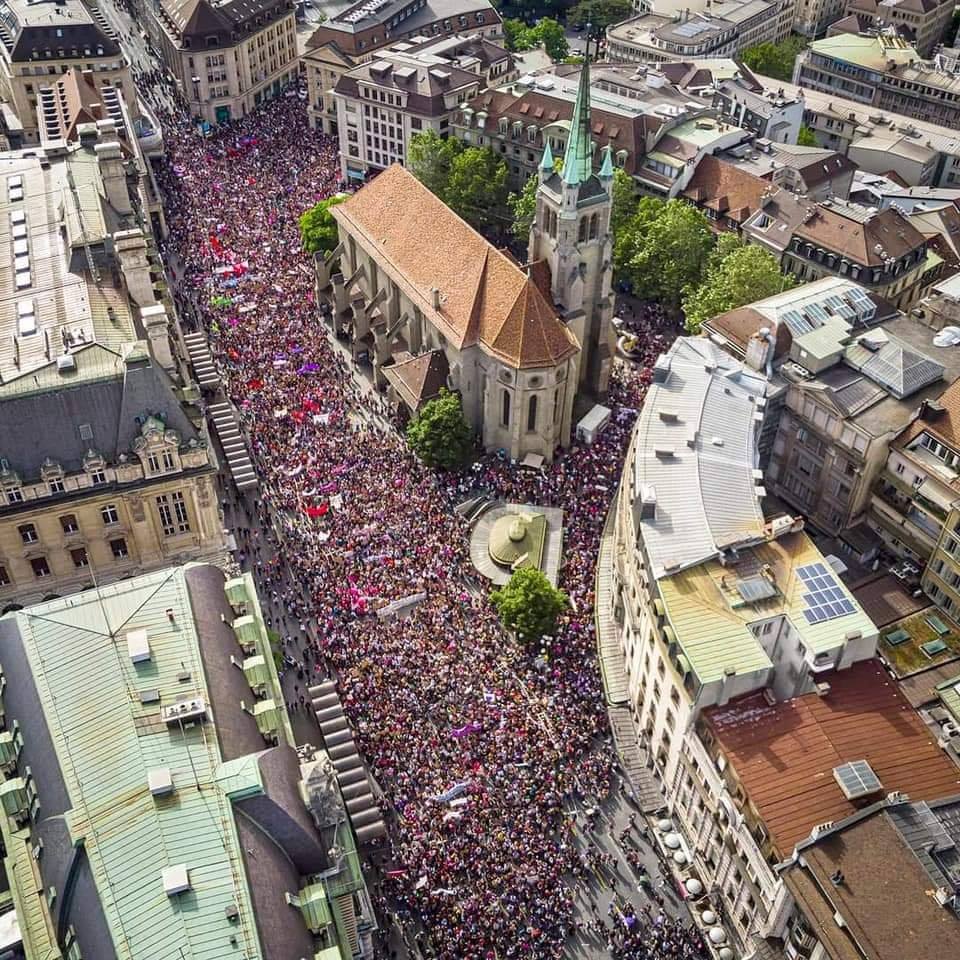On Friday, the 14th of June 2019, hundreds of thousands of women went on strike throughout Switzerland for the second time after 1991. Women of all ages, from all regions and with different employment situations participated in hundreds of protest activities, ranging from putting up banners to squatting streets and central squares. The reasons for taking to the streets to protest were numerous – the patriarchal and capitalist society keeps producing new ones on a daily basis. Despite the political and economic stability in Switzerland overall, the political left succeeded in organizing one of the most successful mass mobilization in Swiss history.
von BFS Zürich
Switzerland and women’s rights
Switzerland may be known for many things and even though many believe that it may be a progressive country, as far as women’s rights are concerned, Switzerland is a particularly drastic example of how a highly globalized, neoliberal economy, the free flow of goods, capital, labour and patriarchal structures can coexist.
In Appenzell, a small canton, the women’s voting rights was only introduced in 1990. But only after being forced to do so by federal authorities. On the national level, the right for women to vote also only exists since 1971. Until 2004, rape in the bond of matrimony wasn’t a criminal offence that the state would have to prosecute (on its own initiative), and maternity protection has only been in place since 2006 – but still only lasts 14 weeks. Paternity leave doesn’t exist – men get one day off after the birth of their child. At the same time, Switzerland has one of the most expensive childcare systems in the world: childcare for a child, five days a week costs up to half of an average wage. Additional to that the working conditions for the caregivers at day-care centres are catastrophic.
Moreover, the gender wage gap is immense. In terms of wages there can be a difference determined which goes up to 30%, even if this difference is often concealed by the statistics and reduced to 10-20%. In addition, there is a shocking number of women who have experienced sexualized violence, assaults, harassment and psychological violence. In Switzerland, a feminicide occurs every two weeks. All those reasons and many more build the basis for the women’s strike 2019.
Why the 14th of June, 2019?
On the 14th of June 1981, a so-called “equality article” was included in the Swiss constitution. This article was intended to provide the legal basis to promote gender equality. But it was of little use. For a long time, the constitutional article only remained a piece of paper until women had enough. On the tenth anniversary of the article, they called out the first nationwide women’s strike on the 14th of June 1991. It was supposed to finally add authority to the women’s demands for real equality.
Many women’s organizations joined this call. Throughout the country on June 14th, women took part in various strike actions and transformed streets and squares into a sea of purple – the color of the women’s movement. In Bern, the closed-off Bundesplatz was stormed whilst whistles were blown, the place where political celebrities had gathered for a celebration of the 700-year-old Swiss Confederation.
The idea for the women’s strike came from female watch workers in the remote Vallée de Joux who were outraged by the unequal wages in their industry that still hadn’t changed (some of them earned only half of their male colleagues!). In October 1990, the Congress of the Swiss Confederation of Trade Unions also decided to join the call and participate at the national women’s strike.
The strike day oriented itself at foreign examples: On 26th of August in 1970, a year before Swiss women were granted the right to vote, a “Women’s Strike for Equality” was held to mark the 50th anniversary of the introduction of women’s voting rights in the United States. The strike focused mainly on New York, but there were also actions in other parts of the country involving a total of about 20,000 women. Even more impressive was the Icelandic women’s strike on October 24th, 1975, in which about 90 percent of the female population stopped working for one day.
The second women’s strike in the history of Switzerland
Many of the problems mentioned in 1991 have not been solved in the last 28 years. Neoliberal restructuring, attacks on the public service sector and the precarisation of entire fields of work have in some cases exacerbated the problems of feminized occupations. For this reason, in the spring of 2018, the idea of calling another nationwide women’s strike was born in the west of Switzerland.
Soon this idea was taken up in various cities and women’s strike collectives were formed. In autumn 2018, the Congress of the Swiss Confederation of Trade Unions joined the call for the women’s strike.

In the preparations for the women’s strike on the 14th of June 2019, women, trans-, inter- and queer people have networked, exchanged and organized in countless committees, working groups, associations, organizations; in daycare centers, neighbourhoods, offices, shops, educational institutions, hospitals and many other social spaces for over a year.
Unlike in 1991, there was no central leadership of the strike preparations. Instead, the main work was carried out locally in the collectives and the various projects were coordinated at national level.
The women’s strike and its demands were intensively discussed in advance. It became apparent that the strike and the problem areas addressed were of great social importance and that many people would join the strike. But nobody could have guessed how big it would actually become.
Well over half a million people participated in the strike. Almost half a million people, mostly women took part at the demonstrations in the various cities and towns, others struck at home or showed their solidarity in a different way. Many larger cities experienced the most massive demonstrations in their recent history. For a country with a population of 8 million inhabitants, this was huge.
An extraordinary day
What happened in Switzerland at the women’s strike day is extraordinary in many ways. It is extraordinary because in recent years there have hardly been any major social movements in this country, which is characterised by working peace agreements and concordance. It is extraordinary because we can observe a worrying rise of right-wing extremist parties around Switzerland – as the European elections at the end of May 2019 once again have confirmed. In virtually all European countries (and beyond) racist, anti-social and anti-feminist parties and organizations are on the rise. In Italy, Hungary and possibly soon again in Austria they are already in government and a change of power is not foreseeable in the near future. Many of these parties openly refer to the Swiss People’s Party (SVP, a far-right populist party) as their role model, which has been the strongest party in Switzerland for years. So, in conclusion, Switzerland is not only far behind in terms of equality but also leads in terms of strong right-wing parties.
It is precisely in this historical situation that Switzerland is experiencing one of the strongest social mobilizations in its recent history. Only rarely before – not even during the women’s strike in 1991 – a social movement was as present in society as the current feminist movement. The women’s strike is of immeasurable value, not only for the political and media discourse to shift to the left. It also has the potential to bring about a lasting change to the balance of power in one of the most stable countries in the world and to contribute to the long-term self-organization of wage-dependent women.
The Swiss women’s strike was embedded in the worldwide upswing of feminist struggles from the very beginning. The Argentinean and Polish feminists, the Women’s Marches in the USA, the “Ni una di meno” movement in Italy and above all the million-strong women’s strikes in the Spanish state in 2018/19 – they all exerted a direct influence on the feminist movement in Switzerland. And these international links are also the great strength of the movement: Knowing that women in Switzerland – in contrast to the women’s strike in 1991 – aren’t striking alone and aren’t detached from the rest of the world can be of crucial importance for its further developments.
Beyond June 14th
The map on 1406.ch shows the incredible variety and extent of the strike activities that took place on the 14th of June. In all major cities and dozens of smaller towns there were work interruptions and extended breaks, walkouts, city strolls, lectures, meetings, blockades and demonstrations.
But the feminist collectives throughout Switzerland have been saying for months that the 14th of June 2019 will not be the end, but the starting signal for a broad feminist network in Switzerland and beyond. Together with the climate strike movement, Switzerland is currently experiencing an upswing in social movements that is supported by hundreds of thousands of activists and is unique in its self-organized form. For the first time years the anti-capitalist, feminist and ecological left has a reason to look forward to the upcoming months.
More Pictures here: https://sozialismus.ch/frauenstreik-liveticker
This article may be published on other platforms and journals. If you have any further questions or need additional information, we are happy to help: info@bfs-zh.ch








